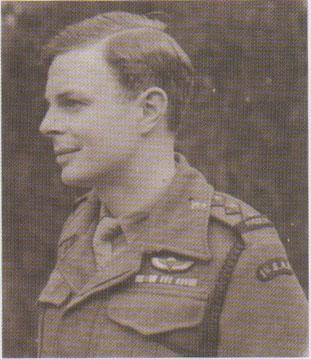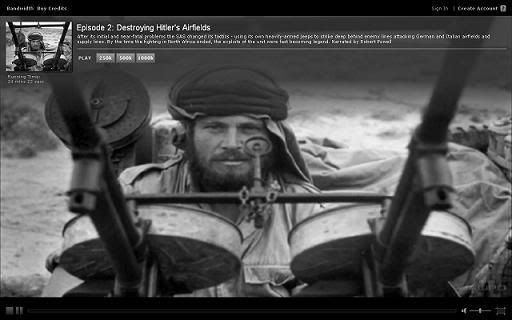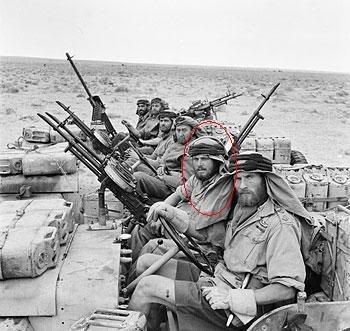I have a weakness for old books, and even though I don't have many, the ones I do own are certainly prized possessions.
I just won a 1945 first edition of Long Range Desert Group: The Story of Its Work 1940-1943, by W.B. Kennedy Shaw. "Sometime Intelligence and Topographical Officer, L.R.D.G." It will have an honored spot on the shelf.

Sunday, April 6, 2008
Monday, March 31, 2008
Iconic photographs


I am currently trying to determine if the soldier highlighted in the well-known picture above is Mike Sadler. Any confirmation available, as well as the names of the other gentlemen in the photograph? I understand that Lieutenant Macdonald is driver of the closest Willy jeep.
Another photo at the very top, shot from a different angle in what are a serious of posed photos, offers a closer view, but I still cannot be certain.
Monday, March 24, 2008
LRDG Training Notes
The past month has been slow. Not as much writing as I'd like, and actually more work and research as I read through several books I picked up following a scrub of other bibliographies.
In order to take a break, but continue to make progress to some degree, I decided to start working on the effort to re-type and digitize the copy of the LRDG Training Notes that I acquired from Jack Valenti. In current military terms, the document is closer to a standard operating procedures text or Aide-mémoire, which would be utilized by units to formalize actions, procedures, and techniques during operations.
This effort alone may take another month, since I want to maintain the formatting of the original document, and I've never been too savvy at maximizing the potential of MS Word.
In order to take a break, but continue to make progress to some degree, I decided to start working on the effort to re-type and digitize the copy of the LRDG Training Notes that I acquired from Jack Valenti. In current military terms, the document is closer to a standard operating procedures text or Aide-mémoire, which would be utilized by units to formalize actions, procedures, and techniques during operations.
This effort alone may take another month, since I want to maintain the formatting of the original document, and I've never been too savvy at maximizing the potential of MS Word.
Monday, February 25, 2008
Looking for the source of my evasion silk map

As you can see from the picture above, I procured a silk map some time ago through an online auction. I'd like to determine the year it was made, to confirm whether the auction description is accurate (it refered to it as a US aircrew evasion map of 1943-vintage). Has anyone out there seen something similar, and knows the genealogy?
Sunday, February 10, 2008
Book reviews
It has been a slow couple of weeks for the project. I've spent the majority of the free time available just thinking about random issues and working on drafts of the outline I have so far. One thing I have been pretty aggressive on is reading as many book reviews as I can get my hands on, with an eye towards ones written on military history books. They serve as an excellent gauge for me on the path I think the outline needs to take. Each review has to be taken with a grain of salt, but they are rather illuminating nonetheless.
Tuesday, January 29, 2008
Theodolite procedures?
I neglected to mention in the "Quest for sources" post that I am also in dire need of a WWII-vintage copy of instructions for manipulating a theodolite. Even better would be an example of a period of instruction that may have been given to LRDG navigators of that era.
Although the equipment has changed significantly, surveying principles have not, so I believe that readers would gain significant insight from how a navigator like Sadler achieved his plot accuracy.
Although the equipment has changed significantly, surveying principles have not, so I believe that readers would gain significant insight from how a navigator like Sadler achieved his plot accuracy.
Sunday, January 27, 2008
Maxwell replies
Well, I received a brief reply from Mr. Maxwell today. He is away for the moment and promises to reply in more detail later in the week.
I am hopeful that my query made sense, as it was just a quick email sent out as the thoughts struck me. Maxwell's reference to Sadler's achievements as "legendary" was motivating!
I am hopeful that my query made sense, as it was just a quick email sent out as the thoughts struck me. Maxwell's reference to Sadler's achievements as "legendary" was motivating!
Wednesday, January 23, 2008
Rare gems
I happened to come across the blogger website of Kit Constable Maxwell at http://kitmax.blogspot.com/ and his posts are fascinating to read, considering he retraced so many of the routes travelled by well-knowns from the ranks of the LRDG. He is next on my list to contact, as I have a keen interest in a file posted to his blog. I hope he can point me to the actual map.
The matter of the LRDG Training Notes makes me wonder if there were ever similar operating procedures put to paper for the early formations on the SAS. As with earlier posts, if anyone happens to drift by here and knows of a source, I would be in your debt.
The matter of the LRDG Training Notes makes me wonder if there were ever similar operating procedures put to paper for the early formations on the SAS. As with earlier posts, if anyone happens to drift by here and knows of a source, I would be in your debt.
Monday, January 21, 2008
And then there was film...
As I went through my notes today, I recalled that founders (well, at least Stirling) of the SAS granted interviews that were recorded on film. In the days of youtube, one would hope that a snippet of two have found there way there, but I haven't had luck tracking any clps down.
If for any reason you happen to know where said interviews may reside today, I definitely need an azimuth to them!
If for any reason you happen to know where said interviews may reside today, I definitely need an azimuth to them!
The quest for sources...
So far I have collected a number of sources that do a pretty good job of documenting LRDG and SAS operations against Rommel and the Italians. The Phantom Major, also titled Stirling's Desert Raiders in previous editions, provides perhaps the most detailed account of the missions that Sadler took part in as either a LRDG navigator, or a member of Stirling's unit once he switched to L Detachment, SAS.
LRDG Rhodesia, The Barce Raid, Stirling's Men, Born of the Desert: With the SAS in North Africa and the works of Lloyd-Owen and Shaw provide more background material and depth. A copy of the LRDG Training Notes, graciously provided by Jack Valenti of the LRDG Preservation Society has provided some very rich primary source detail that otherwise proved difficult to find. Ralph Bagnold's various Royal Geographical Society articles have provided insight into many of the basic principles that the LRDG was built upon, as well as the personality required of these hard men who sailed the sand seas in search of the enemy.
Special Forces in the Desert War 1940-1943 (Public Record Office War Histories) has proven to be a very detailed text that I have poured through repeatedly to cross-reference various raids, actions, and "beat ups" that caused Rommel significant concern druing each of his advances against Commonwealth forces.
Along the way, I've come to own a Howard Mk II sun compass, if for no other reason that to learn the principles by which Sadler was able to plot courses across hundreds of miles of fairly sparse landscapes. At some point I ran across a US aviator's survival map of North Africa, and it is surprisingly detailed considering the expanse of ground it was designed to cover. Copies of that chart now serve as the plotting boards that I have set up to lay out the start points, routes, rendezvous points, and objectives of the many SAS missions.
There are a number of other books that I expect to arrive across the next few weeks. They were purchased after I started a closer review of the material I had on hand, as well as the footnotes from the Clive Gower-Collins article posted to Military History Online: Raids, Road Watches, and Reconnaissance: New Zealand's involvement in the Long Range Desert Group in North Africa, 1940-1943. This article alone provides a significant amount of information that pulls together quotes and passages from other texts and provide an accurate timeline of events. Although Sadler was not a New Zealander, Gower-Collins article provides a peek at the operational and strategic-level impact that the LRDG and SAS had during those tenuous months.
So, why am I telling you all this, you may ask? Well, I am still on the hunt for more primary source materials, particularly photographs that may not have been printed, as well as any letters or texts that reference Sadler. If you happen to come across this site and I triggers a flashback that you have some papers or photos tucked away in a trunk, then I would love to correspond with you and determine if you own something that could help me with the book.
Perhaps most helpful would be actual maps from that era, or at least xerox copies of a map that represents the quality of map that Sadler would have used.
I've yet to complete my plans for travel to the Imperial War Museum for what will certainly be a lengthy visit. I've also been a tad bit negligent in returning correspondence to the Desert Raiders Society. I made a contact there who knows of Sadler's whereabouts and runs across him occasionally; my success in this project requires a face-to-face with Sadler and an interview, without a doubt.
LRDG Rhodesia, The Barce Raid, Stirling's Men, Born of the Desert: With the SAS in North Africa and the works of Lloyd-Owen and Shaw provide more background material and depth. A copy of the LRDG Training Notes, graciously provided by Jack Valenti of the LRDG Preservation Society has provided some very rich primary source detail that otherwise proved difficult to find. Ralph Bagnold's various Royal Geographical Society articles have provided insight into many of the basic principles that the LRDG was built upon, as well as the personality required of these hard men who sailed the sand seas in search of the enemy.
Special Forces in the Desert War 1940-1943 (Public Record Office War Histories) has proven to be a very detailed text that I have poured through repeatedly to cross-reference various raids, actions, and "beat ups" that caused Rommel significant concern druing each of his advances against Commonwealth forces.
Along the way, I've come to own a Howard Mk II sun compass, if for no other reason that to learn the principles by which Sadler was able to plot courses across hundreds of miles of fairly sparse landscapes. At some point I ran across a US aviator's survival map of North Africa, and it is surprisingly detailed considering the expanse of ground it was designed to cover. Copies of that chart now serve as the plotting boards that I have set up to lay out the start points, routes, rendezvous points, and objectives of the many SAS missions.
There are a number of other books that I expect to arrive across the next few weeks. They were purchased after I started a closer review of the material I had on hand, as well as the footnotes from the Clive Gower-Collins article posted to Military History Online: Raids, Road Watches, and Reconnaissance: New Zealand's involvement in the Long Range Desert Group in North Africa, 1940-1943. This article alone provides a significant amount of information that pulls together quotes and passages from other texts and provide an accurate timeline of events. Although Sadler was not a New Zealander, Gower-Collins article provides a peek at the operational and strategic-level impact that the LRDG and SAS had during those tenuous months.
So, why am I telling you all this, you may ask? Well, I am still on the hunt for more primary source materials, particularly photographs that may not have been printed, as well as any letters or texts that reference Sadler. If you happen to come across this site and I triggers a flashback that you have some papers or photos tucked away in a trunk, then I would love to correspond with you and determine if you own something that could help me with the book.
Perhaps most helpful would be actual maps from that era, or at least xerox copies of a map that represents the quality of map that Sadler would have used.
I've yet to complete my plans for travel to the Imperial War Museum for what will certainly be a lengthy visit. I've also been a tad bit negligent in returning correspondence to the Desert Raiders Society. I made a contact there who knows of Sadler's whereabouts and runs across him occasionally; my success in this project requires a face-to-face with Sadler and an interview, without a doubt.
Sunday, January 20, 2008
Inauguration!
Well, after several years of contemplating the need for an original work regarding the exploits of Mike Sadler while he served with the SAS in N. Africa, I finally broke ground. This inaugural post will hopefully be the first of many that detail my progress on the project.
I hope that through these posts and other information posted here, I can expand the network of contacts, resources, and references that will undoubtedly improve the work.
And just what work am I about to embark on? To be specific, I believe that Sadler was a key player in David Stirling's SAS successes during Britain's N. African campaign, yet most texts provide little information beyond the fact that he was a skilled navigator. To the casual observer of SAS history, that may seem like an inconsequential fact, but to someone who has navigated across open desert landscapes (as I have), Sadlers feats are certainly impressive and merit recognition and remembrance.
My initial interest in Sadler stemmed from a read of The Phantom Major: The Story of David Stirling and the SAS Regiment, by Virgina Cowles. This interest grew after my reads of various books detailing the exploits of the Long Range Desert Group and their loose affiliation with the SAS before Stirling acquired his own transport. As someone who has languished over a map with sweat dripping from my brow as I plotted the next leg of my course, I wanted to know more about Sadler. I felt the larger historical and military audience would benefit from learning how Sadler learned to navigate, what standard operating procedures he observed, and how he applied his craft in the harsh conditions of the blistering sands.
Althoug Sadler would likely consider his actions just the job of an average soldier, he most certainly accomplished heroic things.
I hope that through these posts and other information posted here, I can expand the network of contacts, resources, and references that will undoubtedly improve the work.
And just what work am I about to embark on? To be specific, I believe that Sadler was a key player in David Stirling's SAS successes during Britain's N. African campaign, yet most texts provide little information beyond the fact that he was a skilled navigator. To the casual observer of SAS history, that may seem like an inconsequential fact, but to someone who has navigated across open desert landscapes (as I have), Sadlers feats are certainly impressive and merit recognition and remembrance.
My initial interest in Sadler stemmed from a read of The Phantom Major: The Story of David Stirling and the SAS Regiment, by Virgina Cowles. This interest grew after my reads of various books detailing the exploits of the Long Range Desert Group and their loose affiliation with the SAS before Stirling acquired his own transport. As someone who has languished over a map with sweat dripping from my brow as I plotted the next leg of my course, I wanted to know more about Sadler. I felt the larger historical and military audience would benefit from learning how Sadler learned to navigate, what standard operating procedures he observed, and how he applied his craft in the harsh conditions of the blistering sands.
Althoug Sadler would likely consider his actions just the job of an average soldier, he most certainly accomplished heroic things.
Subscribe to:
Posts (Atom)